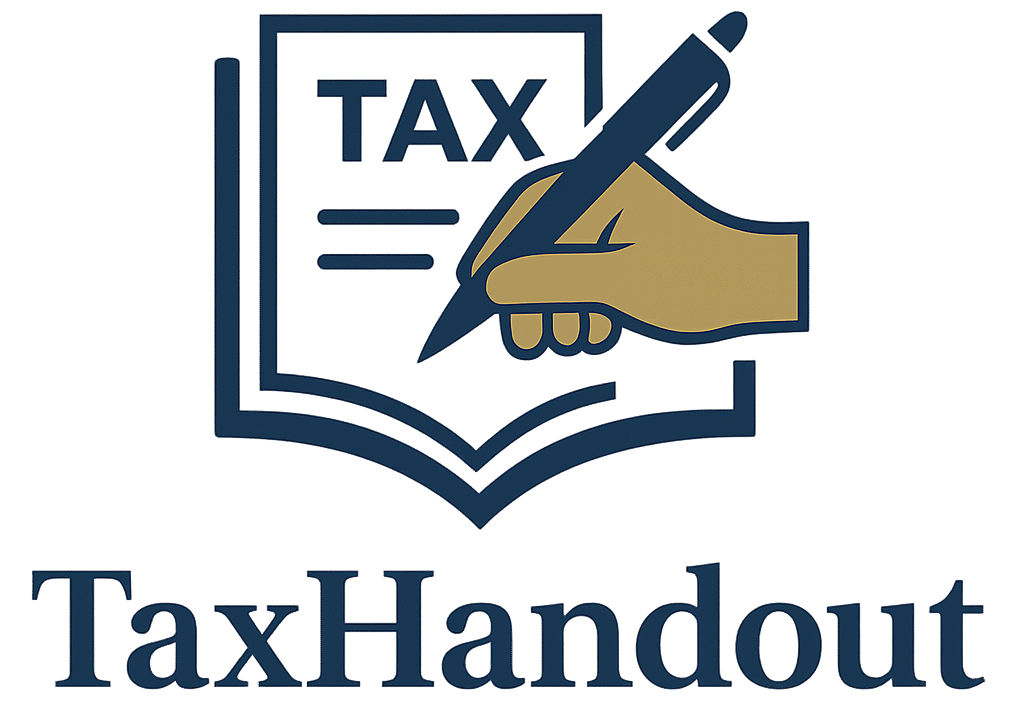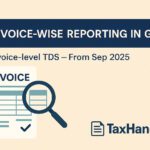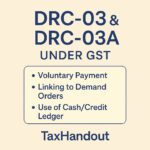In the GST regime, when tax authorities perceive discrepancy (in input tax credit, non-payment, under-payment, or excess refund) they need to issue notices and demand recovery. One of the key initial steps is Form GST DRC-01, which serves as a summary of the show cause notice.
This blog will explain:
- What is DRC-01?
- Legal basis & rules
- When and how it is issued
- Content and structure
- Time limits and limitations
- Rights of the taxpayer (reply, hearing)
- Judicial rulings & controversies
- Common questions & practical tips
What is DRC-01?
- Form GST DRC-01 is the “Summary of Show Cause Notice / Intimation” under Rule 142(1)(a) of the CGST Rules.
- It is not in itself the full show cause notice (SCN) under Section 73/74 of the CGST Act, but an electronic summary or intimation to the taxpayer about a proposed demand.
- The idea is: the proper officer should issue formal SCN (with detailed reasoning) and also serve a summary via DRC-01 in electronic form.
Why a “summary” form?
- To provide transparency: taxpayer gets a concise version of proposed demand
- To standardize communication via the GST portal
- But it cannot substitute the full SCN notice with reasoning and opportunity to be heard. Courts have held that merely issuing DRC-01 (summary) without proper SCN is invalid.
Legal Basis & Rule
| Provision | Purpose / Relevance |
| Section 73 / 74, CGST Act | Powers to determine tax (non-fraud / fraud) and issue show-cause notices |
| Rule 142(1)(a) | Mandates serving summary of notice in DRC-01 along with notice under Section 73 / 74 / other recovery provisions (Commercial Taxes UP) |
| Rule 142 | General Demand & Recovery procedures under CGST Rules |
| Judicial decisions / High Courts | Interpret whether DRC-01 summary alone suffices; emphasize natural justice |
Thus, DRC-01 is anchored in Rule 142, but its proper use depends on compliance with statutory mandates of fair procedure under the Act.
When and how it is issued
DRC-01 is essentially the summary of a Show Cause Notice (SCN). It can be issued by the Proper Officer in multiple situations where recovery of tax, interest, penalty, or erroneous refunds is contemplated. The main grounds are as follows:
1. Non-Payment or Short Payment of Tax (Section 73 of CGST Act)
- Applies when tax is not paid or paid short due to any reason other than fraud, willful misstatement, or suppression.
- Example: Mistake in return filing, clerical error in turnover reporting, mismatch between GSTR-1 and GSTR-3B.
- In such cases, the officer first issues SCN under Section 73, and its summary is served electronically as DRC-01.
2. Cases Involving Fraud, Suppression or Willful Misstatement (Section 74)
- If the officer believes tax has been evaded by fraudulent intention, deliberate suppression of facts, or misrepresentation, then Section 74 applies.
- Here, penalty is harsher (equivalent to tax) and the limitation period is longer.
- The SCN is issued under Section 74, and DRC-01 is the e-summary of that SCN.
3. Erroneous Refunds (Section 73/74 read with Section 54)
- If a taxpayer has received refund of GST wrongly, or in excess of admissible amount, the officer may demand recovery.
- Example: Claiming refund of ITC on exempt supplies, or double claiming refund.
- SCN issued → summary in DRC-01.
4. Wrong Availment or Utilisation of Input Tax Credit (ITC)
- ITC claimed in excess or wrongly (e.g., blocked credits under Section 17(5), mismatch with GSTR-2B, no actual receipt of goods/services).
- Also includes ITC availed but supplier not paid within 180 days, ITC on fake invoices, or ITC reversed but not correctly paid.
- Such cases can fall under Section 73 or 74 depending on intent.
- Demand raised → DRC-01 issued.
5. Tax Collected but Not Paid to Government (Section 76)
- If a registered person has collected tax from customers but has not deposited the same with the Government, recovery can be initiated.
- In such cases, DRC-01 is issued as summary of SCN under Section 76.
- Important: There is no time limit for issuing notice under Section 76.
6. Wrong Distribution of Credit by ISD (Section 73/74 with Section 20)
- If an Input Service Distributor wrongly distributes excess credit to units/branches, recovery proceedings can be initiated.
- DRC-01 can be issued in such cases as well.
7. Other Recovery Scenarios under GST
- Tax not paid within time even after a self-admission in returns (GSTR-3B liability declared but not discharged).
- Transitional credit wrongly carried forward under TRAN-1 / TRAN-2.
- Mismatch noticed during audits, investigations, or scrutiny of returns.
Simplified Table: Legal Grounds for Issuing DRC-01
| Section | Ground for SCN | Basis for DRC-01 | Example |
| Sec. 73 | Non-payment / short payment of tax without fraud | Summary of SCN | GSTR-1 shows higher turnover vs GSTR-3B |
| Sec. 74 | Non-payment / short payment due to fraud / suppression | Summary of SCN | Fake ITC invoices |
| Sec. 76 | Tax collected but not deposited | Summary of SCN | Tax shown in invoice but not paid to govt |
| Sec. 54 + 73/74 | Erroneous refund | Summary of SCN | Refund of ineligible ITC |
| Sec. 20 + 73/74 | Wrong ISD distribution | Summary of SCN | ISD distributed full ITC to one unit |
| Others (Scrutiny/Audit) | Any contravention detected | Summary of SCN | Transitional credit wrongly availed |
Time limits (limitation)
- For “bona fide defaulters” (non-fraud / non-willful), the SCN / summary via DRC-01 must be issued within 2 years + 9 months from due date of filing of annual return of the relevant year.
- For “mala fide / fraud / willful mis-statement / suppression,” extended period applies — 4 years + 6 months from due date of annual return.
- But in cases where tax was collected but not deposited, there is no time limit.
Note: These time limits are for initiating the SCN / summary stage; later, the order under DRC-07 (if passed) has its own outer limits.
Content & Structure of DRC-01
A well-drafted DRC-01 summary should contain:
- Reference / Notice number (unique identifier)
- Taxpayer details (name, address, GSTIN)
- Tax period(s) involved
- Provisions/Sections / Rules under which notice is being issued
- Basic grounds / summary of factual / legal issues (e.g. mismatch in ITC, underpayment)
- Amount demanded (tax, interest, penalty)
- Due date / time for reply
- Hearing date / time (if scheduled) / “NA” if not applicable
- Signature / authentication by proper officer (or digital signature / e-sign)
Note: The summary should enable a taxpayer to know the gist of the case and prepare a response. But it is not enough by itself — the full SCN must be available and consistent with the summary.
Courts have held that attaching a “determination order” or computation as an appendix to DRC-01 does not itself amount to a proper SCN unless the procedural requisites (auditable reasons, signature, hearing opportunity) are met.
Rights of Taxpayer: Reply, Hearing, Limitation
Once DRC-01 (summary) is issued:
- The taxpayer has 7 days (as per common practice / portal) to reply or furnish explanation.
- The taxpayer may also request a personal hearing — the proper officer must provide “reasonable opportunity of hearing” before any adverse order.
- If taxpayer fails to reply within the time, further proceedings may continue, but the right to file reply may be lost in some cases.
Important caution from courts:
- A DRC-01 summary without a proper show cause notice is insufficient; principles of natural justice demand full reasons, signature, and hearing.
- Some High Courts have struck down demands made only on summary DRC-01 without properly authenticated SCN.
Thus, as a taxpayer, one must check whether the full SCN is available and valid, not just rely on DRC-01.
Common Issues / Controversies & Judicial Rulings
- Summary alone cannot substitute SCN
Courts have repeatedly held that DRC-01 summary alone is insufficient to start proceedings — full reasoning and notice must be issued. - Signature / authentication
If DRC-01 or attached documents lack the signature or proper authentication by the proper officer, the notice may be invalid. - Failure to mention hearing date
If the notice does not provide hearing date or time, that may violate the right to hearing (natural justice). - Non-consideration of replies in DRC-01A stage
Sometimes, the taxpayer may file reply under DRC-01A (intimation / reply to summary), but such replies are not considered and authorities issue SCN anyway. - Time bar / limitation disputes
Taxpayers may challenge issuance of DRC-01 if beyond limitation; authorities must justify invocation of extended periods for fraud cases. - Mismatch between summary and SCN
If the summary indicates one ground, but SCN shifts to a different ground or period not intimated earlier, that may be challenged as violation of fair notice.
Practical Tips / Checklist for Taxpayers
- Always check whether the full SCN / statement of demand is available along with DRC-01.
- Ensure DRC-01 is signed / authenticated by proper officer; lacking signature may render it defective.
- Time your reply / request for hearing within prescribed days (usually 7 days in DRC-01).
- In the reply, address all points raised, provide documents, reconcile, explain mismatches.
- Use judicial precedents if applicable (e.g. have courts held similar DRC-01 invalid).
- Maintain records of portal submissions, email communications, etc.
- Engage a tax professional early if demands are large or complex.



